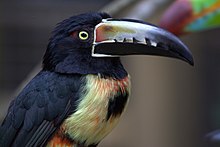Collar arassari
| Collar arassari | ||||||||||
|---|---|---|---|---|---|---|---|---|---|---|

Collared arassari ( Pteroglossus torquatus ) |
||||||||||
| Systematics | ||||||||||
|
||||||||||
| Scientific name | ||||||||||
| Pteroglossus torquatus | ||||||||||
| ( Gmelin , 1788) |
The Collared Aracari ( Pteroglossus torquatus ) is an in Central America beheimateter woodpecker bird from the family of toucans . It belongs to the genus of the Schwarzarassaris and was first described in 1788 by Johann Friedrich Gmelin . It is one of the few species of toucan that has been observed in the wild over a long period of time.
features
Collar arassaris grow to be about 41 centimeters and reach a weight of 230 grams. Their plumage is predominantly black on the head, wings and back, between the wing tips there is a red spot of varying dimensions. The ventral side, on the other hand, is mostly yellowish, a broad, black-red band is characteristic here: the legs are green. The lower beak is usually black, while the upper beak is usually mostly yellow with a few black spikes. The eggs of the animals are white. The bird's call is described as thin and lofty.
The voice of the collar arassari is reminiscent of a light "sneeze" and is onomatopoeically described as ksíyik or pítsek . Aggressively excited collar arassaris also make a grahhrr sound.
distribution and habitat
The distribution area of the collared arassaris extends from Mexico via Panama to Ecuador and Venezuela . There they can be found in wooded plains and moist rainforests, but unlike many other toucan species, they are usually not found in regions above 1500 meters above sea level .
According to the IUCN , the population is currently not at risk.
behavior
The collared arassari often occurs in small groups. Its diet consists mainly of fruits, insects , bird eggs and lizards . You spend the night in old woodpecker caves or naturally formed tree hollows. Field observations suggest that they often stay in family groups during the overnight stay and that there are several overnight caves available to them in their territory.
The bird uses tree hollows as a nesting place, from which it occasionally spends off brooding king and line woodpeckers. Often it is also one of the overnight caves. Both males and females take part in the brood, which lasts about 16 days. The chicks fledge after about 6 weeks, but are still fed a few weeks after leaving the nest. In addition to the parents, other conspecifics also participate in feeding the chicks. These are presumably not yet sexually mature young birds that descended from their parent birds. Collared macaws are the only species of toucan in which such a cooperative breeding system has been clearly demonstrated. However, since the reproductive biology of a number of other toucan species - including in particular the black macaws - has not yet been adequately investigated, it cannot be ruled out that this behavior also occurs in other species. Collared arassaris are considered monogamous .
attitude
Collared arassaris used to be kept more frequently in zoological gardens and bird parks, as well as in private hands. At the beginning of the 20th century, however, there were only three European zoos left with collars. In the 1980s, among other things, Wilhelma in Stuttgart was one of the zoological gardens that successfully bred collared arassaris.
swell
literature
- Werner Lantermann: Toucans and Arassaris. Filander Verlag, Fürth 2002, ISBN 3-930831-46-5
- Lester L. Short and Jennifer FM Horne: Toucans, Barbets and Honeyguides - Ramphastidae, Capitonidae and Indicatoridae . Oxford University Press, Oxford 2001, ISBN 0-19-854666-1
- Alexander Frank Skutch (1958): Roosting and Nesting of Aracari Toucans (PDF; 1.6 MB), in The Condor: 60 (4): 201-219.
Web links
- Videos, photos and sound recordings of Pteroglossus torquatus in the Internet Bird Collection
- Animal Diversity Web: Pteroglossus torquatus
Single receipts
- ↑ Lantermann, p. 139
- ↑ Skutch, AF (1958): Roosting and Nesting of Aracari Toucans (PDF; 1.6 MB), in The Condor: 60 (4): p. 202.
- ↑ Lantermann, p. 141
- ↑ Pteroglossus torquatus in the endangered Red List species the IUCN 2011. Posted by: BirdLife International, 2009. Accessed November 13, 2011th
- ↑ Lantermann, p. 139
- ↑ Kilham, L. (1977): Pale-Billed Woodpeckers Robbed of Nest Hole By Collared Aracaris (PDF; 173 kB) in Auk: 94 (4): 774-775.
- ↑ Lantermann, p. 140
- ↑ Lantermann, p. 140
- ↑ Lantermann, p. 141

